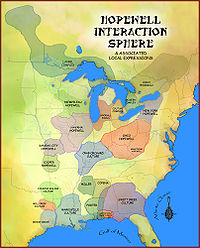- Deptford culture
-
The Deptford culture (2500 BCE—100 BCE) was characterized by the appearance of elaborate ceremonial complexes, increasing social and opolitical complexity, mound burial, permanent settlements, population growth, and an increasing reliance on cultigens.
Contents
Origins
Deptford is named for the Deptford area of south Savannah, Georgia. Origins of the Deptford culture are not established though most archaeologists argue for stationary (situ) development. Views differ on the chronological divisions for Deptford but most concur with three phases of Early Deptford, Middle Deptford, and Late Deptford (W.H. Sears, 1962)
Population sites
The Deptford sites can be found from eastern North Carolina along the east coast to Florida.
- Tar River, North Carolina[1]
- Brewton Hill site, eastern Savannah, Georgia
- Dulany site, eastern Savannah
- Irene site, northwest of Savannah
- Refuse site, north of Savannah
- Meldrim site, southeast of Savannah
- Haven Home site, southwest of Savannah
- The Block-Sterns site, Lake Lafayette, Tallahassee, Florida[2]
- Site 8LE484 on the northern shore of Lake Miccosukee, Leon County, Florida.[3]
Both Florida locations represent significant inland Deptford period sites.
Artifacts
Early Deptford ceramics appear to have been developed in Georgia around 2,600 years ago out of the Early Woodland Refuge phase (near Savannah) some 3,200 to 2,600 BCE years ago, and spread north into South Carolina and North Carolina and south into Florida. Deptford ceramics continued to be made and found on Middle Woodland sites in the southeastern U.S. until about 600 BCE. Occupation for the Atlantic coastal plain of Georgia and the Carolinas seems to have followed a seasonal pattern of winter shellfish camps on the coast, then inland occupation during the spring and summer for deer hunting, and fall for nut gathering.[4]
From the Early through the Middle Woodland periods, the extensive, low-lying coastal environment of the South Atlantic coast, stretching from North Carolina to northern Florida, was used by numerous Deptford hunter-gatherer bands who lived seasonally within a variety of ecosystems and took advantage of seasonally available foods.
Along the Gulf Coast, the Deptford culture continued the seasonal existence throughout the Middle Woodland. Settlements in this geographical area lacked permanence of occupation, although the cultures here participated in the Hopewellian trading network to a limited extent and constructed numerous low sand burial mounds. These sand burial mounds along coastal Georgia and Florida (noted at Canaveral National Seashore and Cumberland Island National Seashore, for instance), as well as in the Carolinas, are believed to represent local lineage burial grounds rather than the resting place of an elite individual.
In northwestern Florida, the Early Woodland Deptford culture evolved in place to become the Santa Rosa-Swift Creek culture. Trade items recovered from burial mounds include copper panpipes, ear ornaments, stone plummets, and stone gorgets. These show this area's incorporation within the Hopewellian Interaction Sphere by about 1,900 years ago.
Sources
 Hopewellian peoples
Hopewellian peoplesWoodland period · List of Hopewell sites · Mound builder (people) · List of archaeological periods (North America) Ohio Hopewell Beam Farm · Benham Mound · Cary Village Site · Cedar-Bank Works · Dunns Pond Mound · Ellis Mounds · Ety Enclosure · Ety Habitation Site · Fort Ancient · Fortified Hill Works · Great Hopewell Road · High Banks Works · Hopeton Earthworks · Hopewell Culture National Historical Park · Indian Mound Cemetery · Keiter Mound · Marietta Earthworks · Moorehead Circle · Mound of Pipes · Nettle Lake Mound Group · Newark Earthworks · Oak Mounds · Perin Village Site · Portsmouth Earthworks · Seip Earthworks and Dill Mounds District · Shawnee Lookout · Tremper Mound and Works · Williamson Mound Archeological District
Crab Orchard culture Goodall Focus Goodall Site · Norton Mound GroupHavana Hopewell culture Kansas City Hopewell Marksville culture Miller culture Point Peninsula Complex Swift Creek culture Etowah Indian Mounds · Leake Mounds · Kolomoki Mounds Historic Park · Miner's Creek site, · Nacoochee Mound · Swift Creek mound site · Yearwood siteOther Hopewellian peoples Armstrong culture · Copena culture · Fourche Maline culture · Laurel Complex · Saugeen Complex · Old Stone Fort (Tennessee)Exotic trade items Related topics · Ancient Monuments of the Mississippi Valley · Black drink · burial mound · Calumet (pipe) · Effigy mound · Hopewell pottery · Horned Serpent · Eastern Agricultural Complex · Underwater panther Categories:- Hopewellian peoples
- Archaeological cultures of North America
- Mound builders (people)
- Native American history of Georgia (U.S. state)
- Native American history of Florida
- Native American history of Alabama
- Classic period in the Americas
Wikimedia Foundation. 2010.


